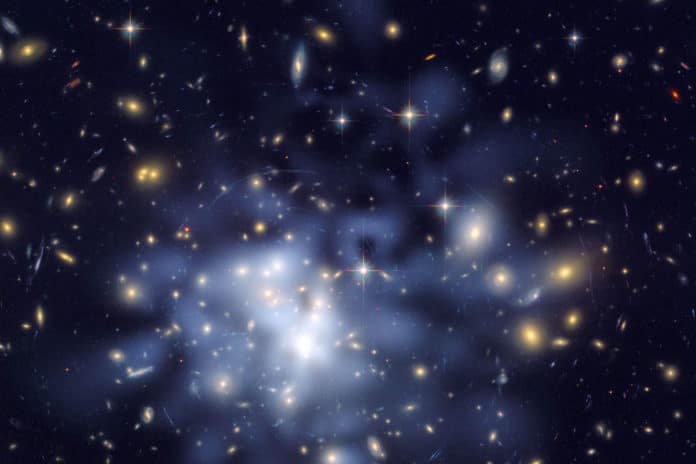The analysis of spiral galaxy rotation curves has empirically highlighted since the late 1970s -a discrepancy between the amount of luminous matter and the mass budget required to explain the overall kinematic properties of such systems. The common belief traces back the missing mass to an unseen component called dark matter, constituted by cold (i.e., nonrelativistic) and weakly interacting massive particles. Despite such a cold dark matter paradigm proving to be relatively successful on cosmological scales, it struggles to fully describe the observed phenomenology on galactic scales, especially in dark matter-dominated dwarfs.
So, there must be secret language communication between dark matter and standard matter in the Universe. What is it? Gravity could be the reason for this discussion.
A new SISSA study published in “The Astrophysical Journal” sheds light on this long-standing issue.
The authors of the research, Ph.D. Student Giovanni Gandolfi and supervisors Andrea Lapi and Stefano Liberati propose a special property for dark matter called a “non-minimal coupling with gravity.”
This new type of interaction can modify dark matter gravitational influence on standard ‘baryonic’ matter. According to the authors, the ‘non-minimal coupling’ could be the key to decrypting the enigmatic dialogue between the two components, possibly solving one of the biggest open questions about the nature of dark matter.
The assumption has been tested and then confirmed with experimental data from thousands of spiral galaxies to prove the hypothesis.
Interaction between dark matter and standard matter
“Dark matter is everywhere,” says the research’s authors.
“Like a cosmic scaffolding, it interconnects the Universe and holds galaxies together. Dark matter is as important as mysterious, though. Possibly, one of dark matter’s greatest enigmas is its interplay with standard matter, or ‘baryons'”.
We know that gravity has an important role in this dialogue, but scientists still don’t entirely understand the phenomenon.
“For this reason,” say Gandolfi, Lapi, and Liberati, “we asked ourselves: is gravity wrong, or are we just missing something crucial about dark matter’s nature? What if dark matter and standard ‘baryonic’ matter do not communicate in the way we have always imagined?. With our research, we have tried to answer these intriguing questions”.
The ‘non-minimal coupling,’ the key to decrypting dialogue
The new study suggests the existence of a new feature of dark matter, named ‘non-minimal coupling,’ which “can be described as a new type of interaction between dark matter and gravity,” the authors affirm.
“It tells us a lot about the way the two components “communicate”.
If the non-minimal coupling is present, standard matter “perceives” spacetime in a way that is different from the one “experienced” by the dark matter. This is a very interesting point. Usually, in fact, dark matter and baryonic matter perceive spacetime in the same way.
For this reason, our theory, which we have proven to be in remarkable agreement with present experimental data, could represent a crucial issue in understanding the essence of dark matter”.
For a global comprehension of dark matter
The new study proposes a solution to one of the most discussed problems in astrophysics; researchers say: “Among other things, the positions of those who argue that dark matter does not exist, and therefore gravity must be modified, are based on the difficulty of finding an explanation to this problem, which is one of the last missing pieces for a global comprehension of dark matter”.
But there is more. “This feature of dark matter is not a piece of new exotic fundamental physics,” the author says. “One can explain the existence of this non-minimal coupling with known physics alone.”
Characteristics of study:
- Researchers have found that the non minimal coupling model can fit the stacked rotational curves of local spiral galaxies with different average velocities at the optical radius, including dwarfs and low-surface-brightness systems.
- Researchers have shown that at the same time, their NMC model, when extrapolating down to smaller masses, the mass-dependent scaling of the coupling length scale found from the analysis of the rotational curves, can adequately reproduce in shape and scatter down to the dwarf spheroidal galaxy range, a task which constitutes a serious challenge for alternative dark matter profiles even inclusive of baryonic effects.
Futuristic view
“The future of dark matter looks brighter” the authors conclude. “Further studies will be carried out to explore all the interesting implications of this proposed new feature of dark matter. We wouldn’t be surprised to discover that this non-minimal coupling could solve other unanswered questions of the Universe”.
Journal Reference
- Giovanni Gandolfi, Andrea Lapi and Stefano Liberati. Empirical Evidence of Nonminimally Coupled Dark Matter in the Dynamics of Local Spiral Galaxies? The Astrophysical Journal 929 48, 2022. DOI: 10.3847/1538-4357/ac5970
